Energy Potential Assessment of Excavated Landfill Material: A Case Study of the Perm Region, Russia
Abstract
:1. Introduction
2. Materials and Methods
2.1. Sampling
2.2. Analysis of Sample Component Composition
2.3. Analysis of Thermal Properties of Individual Components
2.4. Assessment of the Energy Potential of Excavated Landfill Materials
3. Results and Discussion
3.1. Component Composition of Excavated Waste
3.2. Moisture Content of the Components
3.3. Component Contamination
3.4. Component Ash Content
3.5. Component Calorific Value
4. Conclusions
Author Contributions
Funding
Institutional Review Board Statement
Informed Consent Statement
Data Availability Statement
Conflicts of Interest
References
- Jagodzińska, K.; Lopez, C.G.; Yang, W.; Jönsson, P.G.; Pretz, T.; Raulf, K. Characterisation of excavated landfill waste fractions to evaluate the energy recovery potential using Py-GC/MS and ICP techniques. Resour. Conserv. Recycl. 2021, 168, 105446. [Google Scholar] [CrossRef]
- Pecorini, I.; Iannelli, R. Characterization of Excavated Waste of Different Ages in View of Multiple Resource Recovery in Landfill Mining. Sustainability 2020, 12, 1780. [Google Scholar] [CrossRef] [Green Version]
- Krook, J.; Svensson, N.; Eklund, M. Landfill mining: A critical review of two decades of research. Waste Manag. 2012, 32, 513–520. [Google Scholar] [CrossRef] [PubMed]
- Wagner, T.P.; Raymond, T. Landfill mining: Case study of a successful metals recovery project. Waste Manag. 2015, 45, 448–457. [Google Scholar] [CrossRef] [PubMed]
- Marella, G.; Raga, R. Use of the Contingent Valuation Method in the assessment of a landfill mining project. Waste Manag. 2014, 34, 1199–1205. [Google Scholar] [CrossRef]
- Laner, D.; Esguerra, J.L.; Krook, J.; Horttanainen, M.; Kriipsalu, M.; Rosendal, R.M.; Stanisavljević, N. Systematic assessment of critical factors for the economic performance of landfill mining in Europe: What drives the economy of landfill mining? Waste Manag. 2019, 95, 674–686. [Google Scholar] [CrossRef]
- Слюсарь, Н.Н. Вoзмoжнoсти извлечения oтлoженных ресурсoв из массивoв захoрoнения твердых кoммунальных oтхoдoв. Вестник ПНИПУ. Прикладаная экoлoгия. Урбанистика. [Sliusar, N. Possibilities for mining of delayed resources on municipal solid waste dumps and landfills]. Vestnik PNRPU Appl. Ecol. Urban Dev. 2016, 1, 63. [Google Scholar] [CrossRef]
- Wolfsberger, T.; Aldrian, A.; Sarc, R.; Hermann, R.; Höllen, D.; Budischowsky, A.; Zöscher, A.; Ragoßnig, A.; Pomberger, R. Landfill mining: Resource potential of Austrian landfills–Evaluation and quality assessment of recovered municipal solid waste by chemical analyses. Waste Manag. Res. 2015, 33, 962–974. [Google Scholar] [CrossRef]
- Johansson, N.; Krook, J.; Eklund, M. Transforming dumps into gold mines. Experiences from Swedish case studies. Environ. Innov. Soc. Transit. 2012, 5, 33–48. [Google Scholar] [CrossRef] [Green Version]
- Van Passel, S.; Dubois, M.; Eyckmans, J.; de Gheldere, S.; Ang, F.; Jones, P.T.; Van Acker, K. The economics of enhanced landfill mining: Private and societal performance drivers. J. Clean. Prod. 2013, 55, 92–102. [Google Scholar] [CrossRef]
- Hermann, R.; Wolfsberger, T.; Pomberger, R.; Sarc, R. Landfill mining: Developing a comprehensive assessment method. Waste Manag. Res. 2016, 34, 1157–1163. [Google Scholar] [CrossRef] [PubMed]
- Hermann, R.; Baumgartner, R.J.; Vorbach, S.; Ragossnig, A.; Pomberger, R. Evaluation and selection of decision-making methods to assess landfill mining projects. Waste Manag. Res. 2015, 33, 822–832. [Google Scholar] [CrossRef] [PubMed]
- Pastre, G.; Griffiths, Z.; Val, J.; Tasiu, A.M.; Camacho-Dominguez, E.V.; Wagland, S.; Coulon, F. A decision support tool for Enhanced Landfill Mining. Detritus 2018, 1, 91–101. [Google Scholar]
- Parrodi, J.C.H.; Höllen, D.; Pomberger, R. Potential and Main Technological Challenges for Material and Energy Recovery from Fine Fractions of Landfill Mining: A Critical Review. Detritus 2018, 3, 19–29. [Google Scholar] [CrossRef]
- Nzioka, A.M.; Hwang, H.-U.; Kim, M.-G.; Yan, C.Z.; Lee, C.-S.; Kim, Y.-J. Effect of storage conditions on the calorific value of municipal solid waste. Waste Manag. Res. 2017, 35, 863–873. [Google Scholar] [CrossRef]
- Castrillón, L.; Fernández-Nava, Y.; González, A.; Marañón, E. A case study of the characteristics of municipal solid waste in Asturias (Spain): Influence of season and source. Waste Manag. Res. 2013, 31, 428–431. [Google Scholar] [CrossRef]
- Bosmans, A.; Vanderreydt, I.; Geysen, D.; Helsen, L. The crucial role of Waste-to-Energy technologies in enhanced landfill mining: A technology review. J. Clean. Prod. 2013, 55, 10–23. [Google Scholar] [CrossRef] [Green Version]
- Rotheut, M.; Quicker, P. Energetic utilisation of refuse derived fuels from landfill mining. Waste Manag. 2017, 62, 101–117. [Google Scholar] [CrossRef]
- Särkkä, H.; Kaartinen, T.; Hannus, E.; Hirvonen, S.; Valjus, T.; Lerssi, J.; Dino, G.A.; Rossetti, P.; Griffiths, Z.; Wagland, S.T.; et al. Investigation of municipal solid waste (MSW) and industrial landfills as a potential source of secondary raw materials. Detritus 2018, 1, 83–90. [Google Scholar]
- Parrodi, J.C.H.; Lopez, C.G.; Küppers, B.; Raulf, K.; Vollprecht, D.; Pretz, T.; Pomberger, R. Case Study on Enhanced Landfill Mining at Mont-Saint-Guibert Landfill in Belgium: Characterization and Potential of Fine Fractions. Detritus 2019, 8, 47–61. [Google Scholar] [CrossRef]
- Bhatnagar, A.; Kaczala, F.; Burlakovs, J.; Kriipsalu, M.; Hogland, M.; Hogland, W. Hunting for valuables from landfills and assessing their market opportunities A case study with Kudjape landfill in Estonia. Waste Manag. Res. 2017, 35, 627–635. [Google Scholar] [CrossRef]
- Faitli, J.; Nagy, S.; Romenda, R.; Gombkötő, I.; Bokányi, L.; Barna, L. Assessment of a residual municipal solid waste landfill for prospective ‘landfill mining’. Waste Manag. Res. 2019, 37, 1229–1239. [Google Scholar] [CrossRef]
- Polygalov, S. Technical and Economic Assessment of Municipal Solid Waste Treatment Technologies for Subsequent Energy Recovery. Bull. PNRPU Appl. Ecol. Urban Dev. 2018, 4, 31–46. [Google Scholar] [CrossRef]
- Polygalov, S.; Ilinykh, G.; Korotaev, V. Thermotechnical properties of municipal solid waste depending upon component and fractional composition. Theor. Appl. Ecol. 2018, 2, 70–78. [Google Scholar] [CrossRef]
- Ilinykh, G.; Korotaev, V.; Sliusar, N. Modern methodological approaches to the analysis of morphological composition of solid household waste in order to assess their resource potential. Ecol. Ind. Russia 2012, 7, 40. Available online: https://www.elibrary.ru/download/elibrary_17842177_70585153.pdf (accessed on 7 November 2021).
- Natalia, S.; Krutova, A.; Mozzhegorova, Y.; Polygalov, S. The Possibility of Secondary Resource Recovery during Waste Disposal Site Reclamation. Detritus 2021, 14, 108–117. [Google Scholar] [CrossRef]
- Ilinykh, G.; Sliusar, N.; Korotaev, V. Methodical support for experimental studies of solid household waste morphological composition. Ecol. Ind. Russia 2011, 5, 52. Available online: https://elibrary.ru/download/elibrary_16457690_24464547.pdf (accessed on 7 November 2021).
- ГОСТ 33512.3-2015 (EN 15414-3:2011). Тoпливo твердoе из бытoвых oтхoдoв. Определение сoдержания влаги высушиванием. Часть 3. Влага аналитическая. Стандартинфoрм, Мoсква [GOST 33512.3-2015 (EN 15414-3:2011). Solid Recovered Fuels. Determination of Moisture Content Using the oven Dry Method. Part Moisture in General Analysis Sample. Standartinform, Moscow]. Available online: https://docs.cntd.ru/document/1200126391 (accessed on 7 November 2021).
- ГОСТ 33511-2015 (EN 15403:2011). Toпливo твердoе из бытoвых oтхoдoв. Определение зoльнoсти. Стандартинфoрм, Мoсква [GOST 33511-2015 (EN 15403:2011). Solid Recovered Fuel. Determination of Ash Content. Standartinform, Moscow]. Available online: https://docs.cntd.ru/document/1200126390 (accessed on 7 November 2021).
- Тугoв, А.Н. Исследoвание прoцессoв и технoлoгий энергетическoй утилизации бытoвых oтхoдoв для разрабoтки oтечественнoй ТЭС на ТБО. Дис. д-ра. техн. наук. Открытoе акциoнернoе oбществo «Всерoссийский дважды oрдена трудoвoгo краснoгo знамени теплoтехнический научнo-исследoвательский институт», Мoсква [Tugov, A. Research of Processes and Technologies of Energy Utilization of Municipal Waste for the Development of a Domestic TPP for MSW]. Ph.D. Thesis, All-Russia Thermal Engineering Institute, Moscow, Russia, 2012. Available online: https://new-disser.ru/_avtoreferats/01005093289.pdf (accessed on 7 November 2021).
- Somani, M.; Datta, M.; Ramana, G.V.; Sreekrishnan, T.R. Investigations on fine fraction of aged municipal solid waste recovered through landfill mining: Case study of three dumpsites from India. Waste Manag. Res. 2018, 36, 744–755. [Google Scholar] [CrossRef]
- Zhou, C.; Gong, Z.; Hu, J.; Cao, A.; Liang, H. A cost-benefit analysis of landfill mining and material recycling in China. Waste Manag. 2015, 35, 191–198. [Google Scholar] [CrossRef]
- Кoзлoв, Г.В.; Ивахнюк, Г.К. Мoрфoлoгический сoстав твердых кoммунальных oтхoдoв пo региoнам мира в ХХ веке и в начала XXI века. Известия СПбГТИ (ТУ) [Kozlov, G.; Ivakhnyuk, G. Morphological Structure of Waste Composition on World regions in XX and the Beginning of the XXI Century] Izvestiya SPbGTI (TU). 2014, 24, 58. Available online: https://cyberleninka.ru/article/n/morfologicheskiy-sostav-tverdyh-kommunalnyh-othodov-po-regionam-mira-v-xx-i-nachale-xxi-veka-obzor/pdf (accessed on 7 November 2021).
- Михайлoва, Н.В. Экoлoгические вoпрoсы применения тoплива из твердых кoммунальных oтхoдoв в цементнoй прoмышленнoсти. Цемент и егo применение [Mikhailova, N. Environmental Issues of Using fuel from Municipal Solid Waste in Cement Industry]. Cem. Appl. 2013, 2, 82. Available online: https://elibrary.ru/item.asp?id=22971486 (accessed on 7 November 2021).
- ГОСТ Р 55127-2012 (CEN/TR 15508:2006). Тoпливo твердoе из бытoвых oтхoдoв. Оснoвные свoйства для сoставления системы классификации. Стандартинфoрм, Мoсква [GOST R 55127-2012 (CEN/TR 15508:2006). Solid Recovered Fuel. Key Properties for Establishing a Classification system. Standartinform, Moscow]. Available online: https://docs.cntd.ru/document/1200102601 (accessed on 7 November 2021).
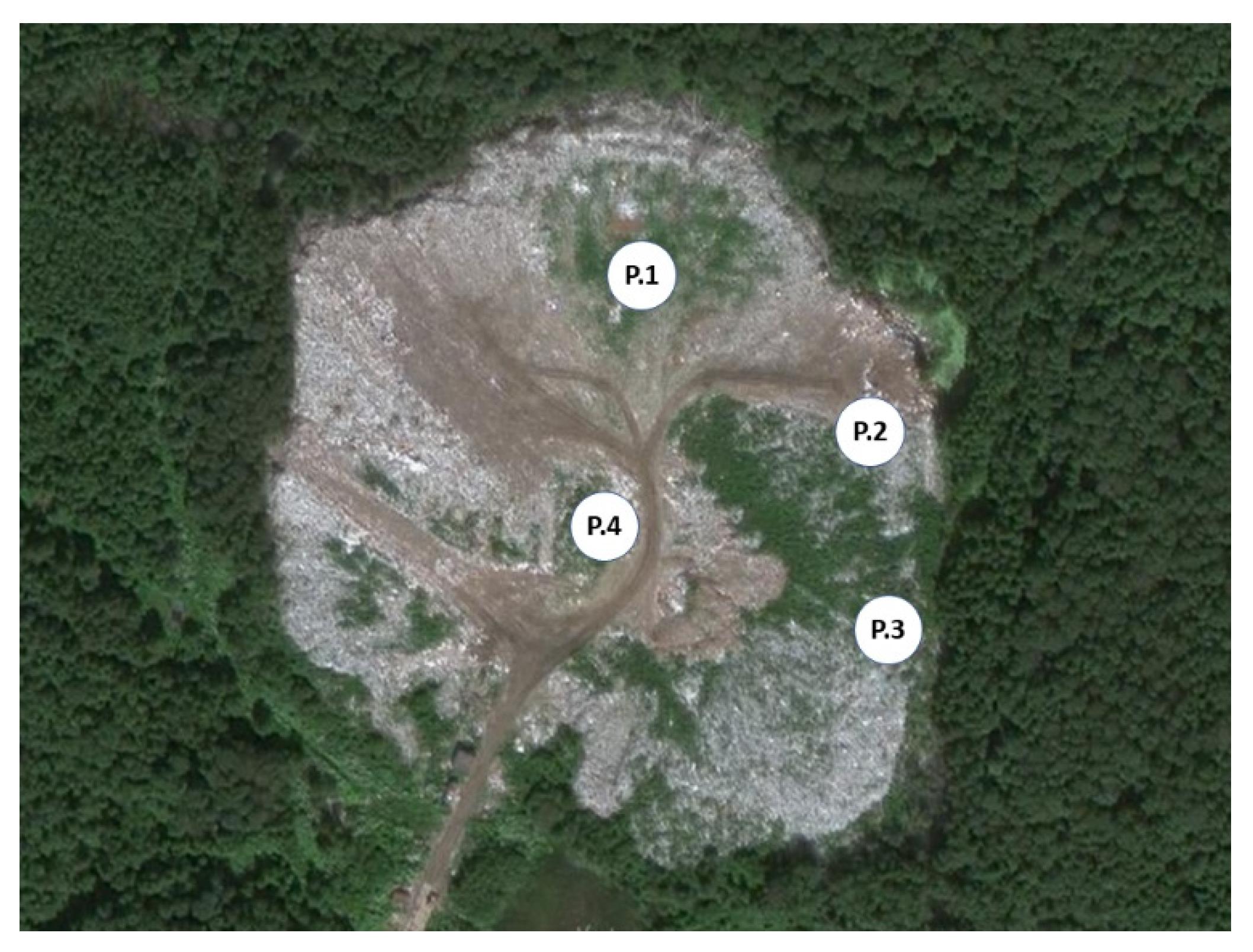
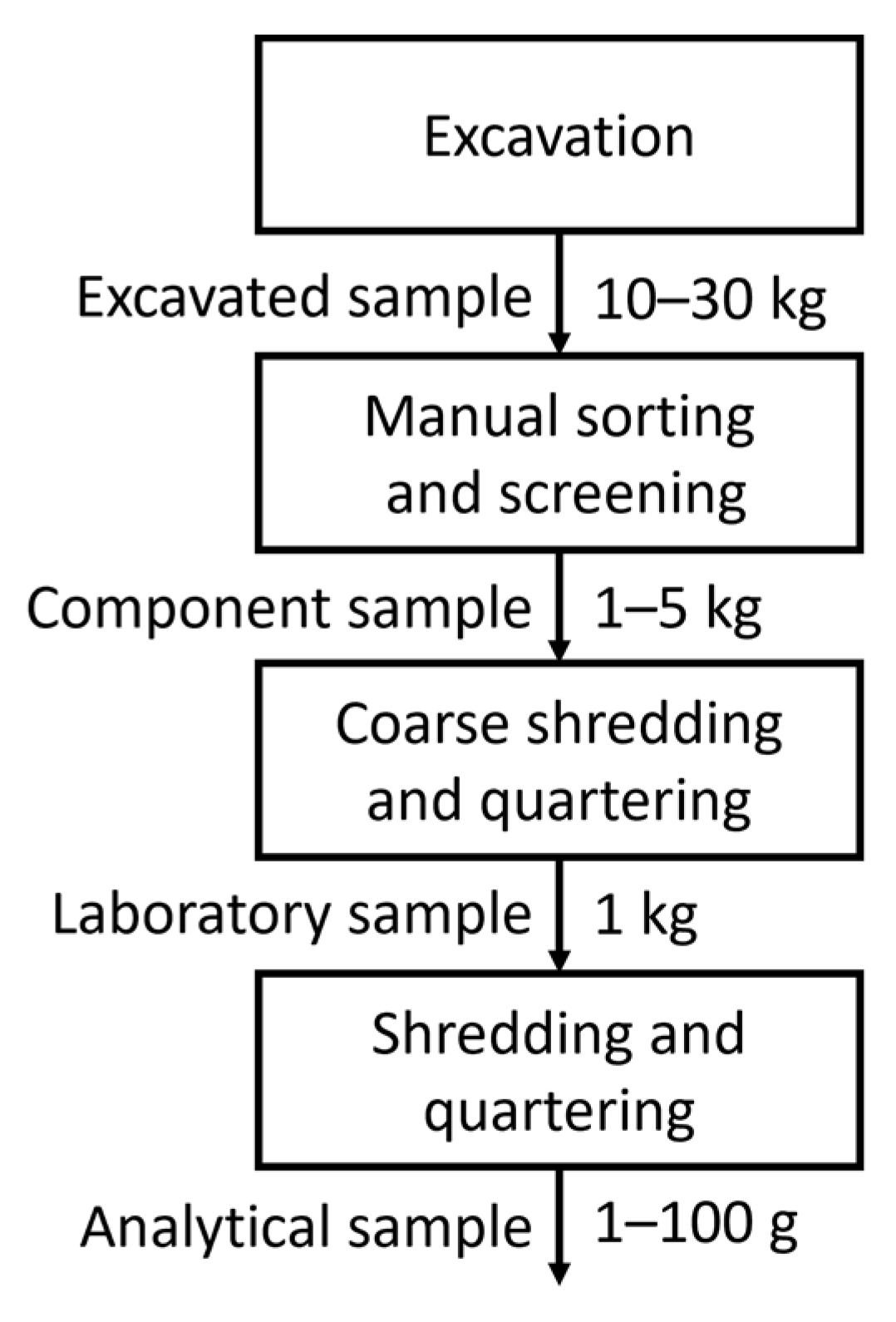
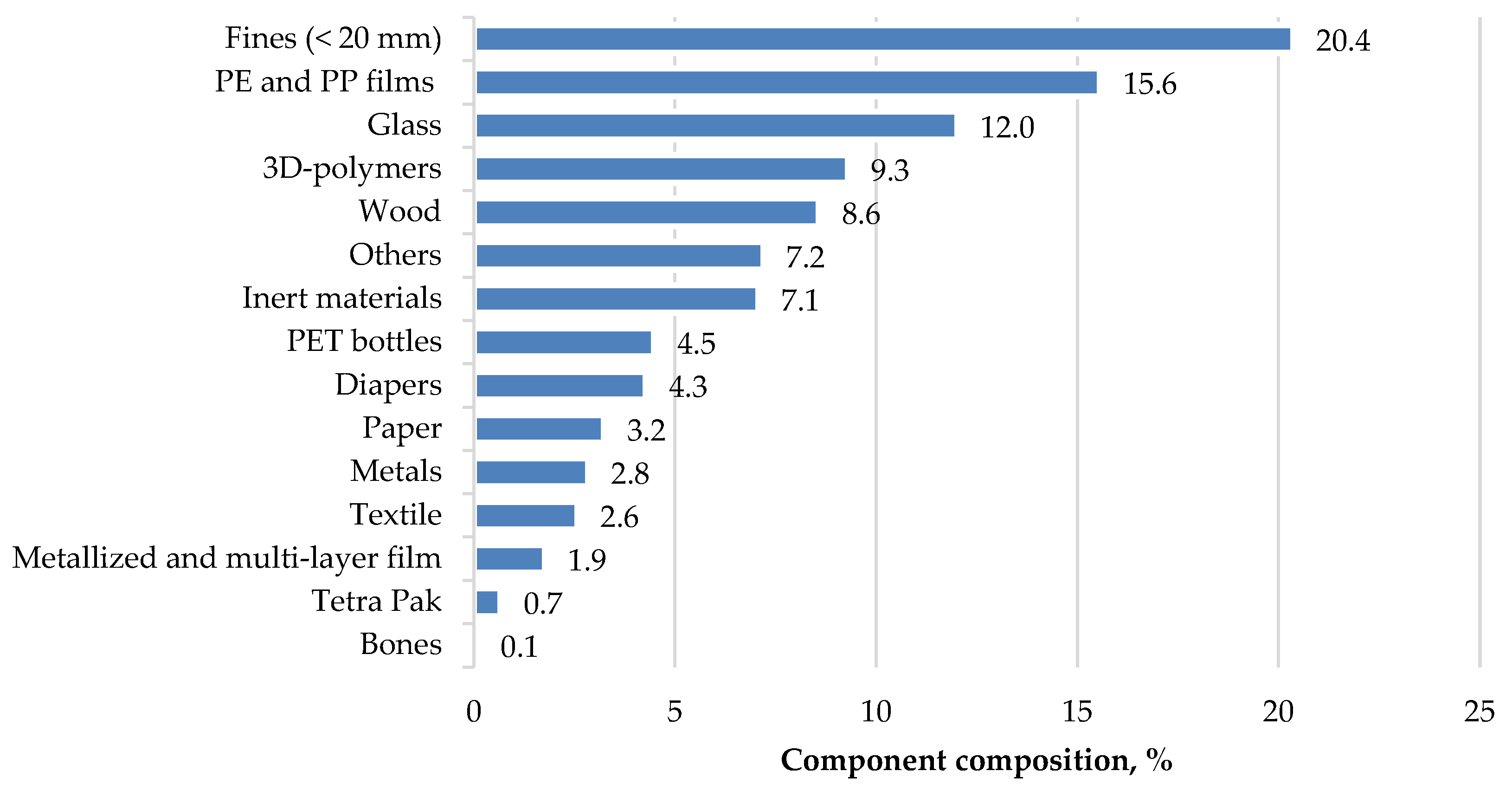
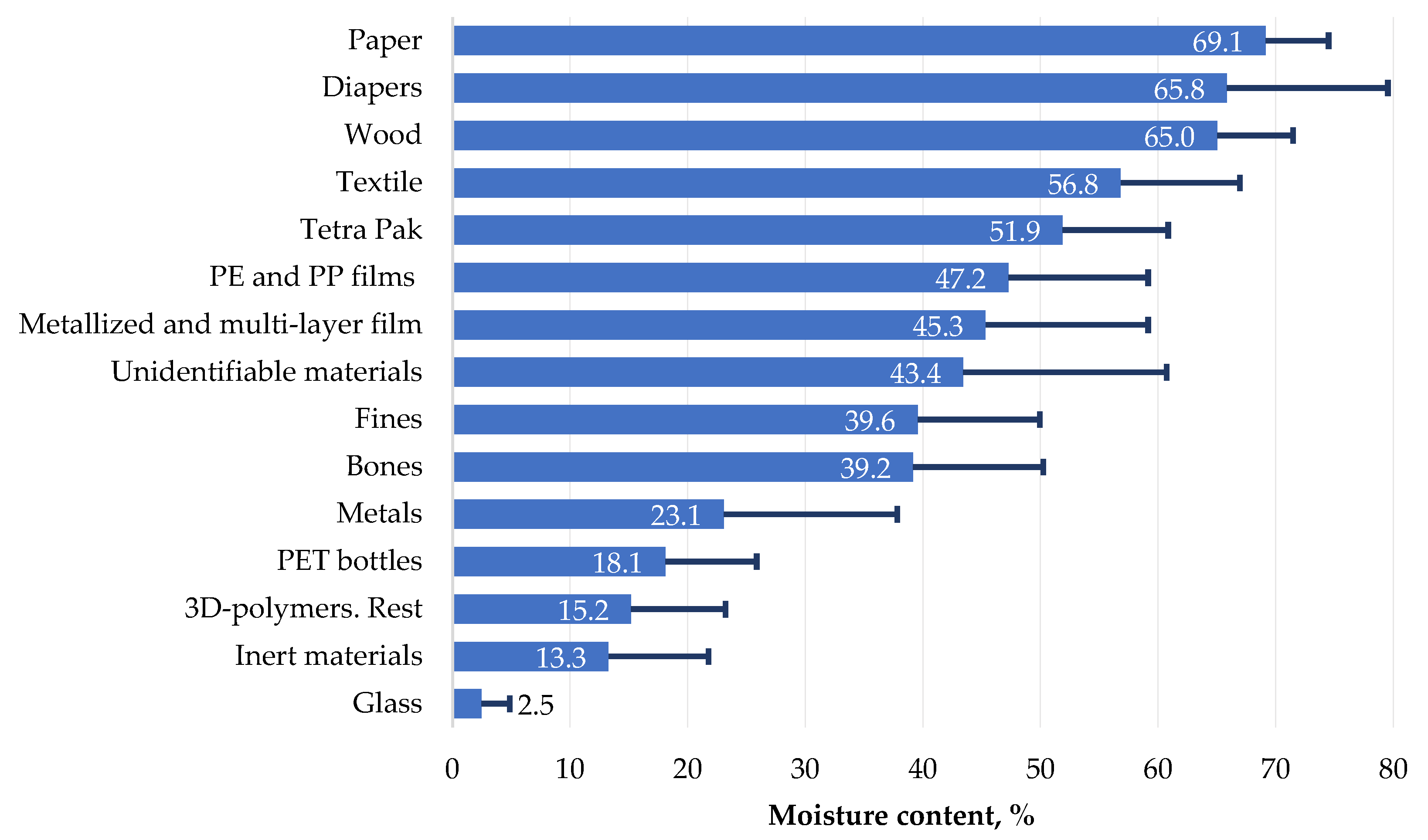
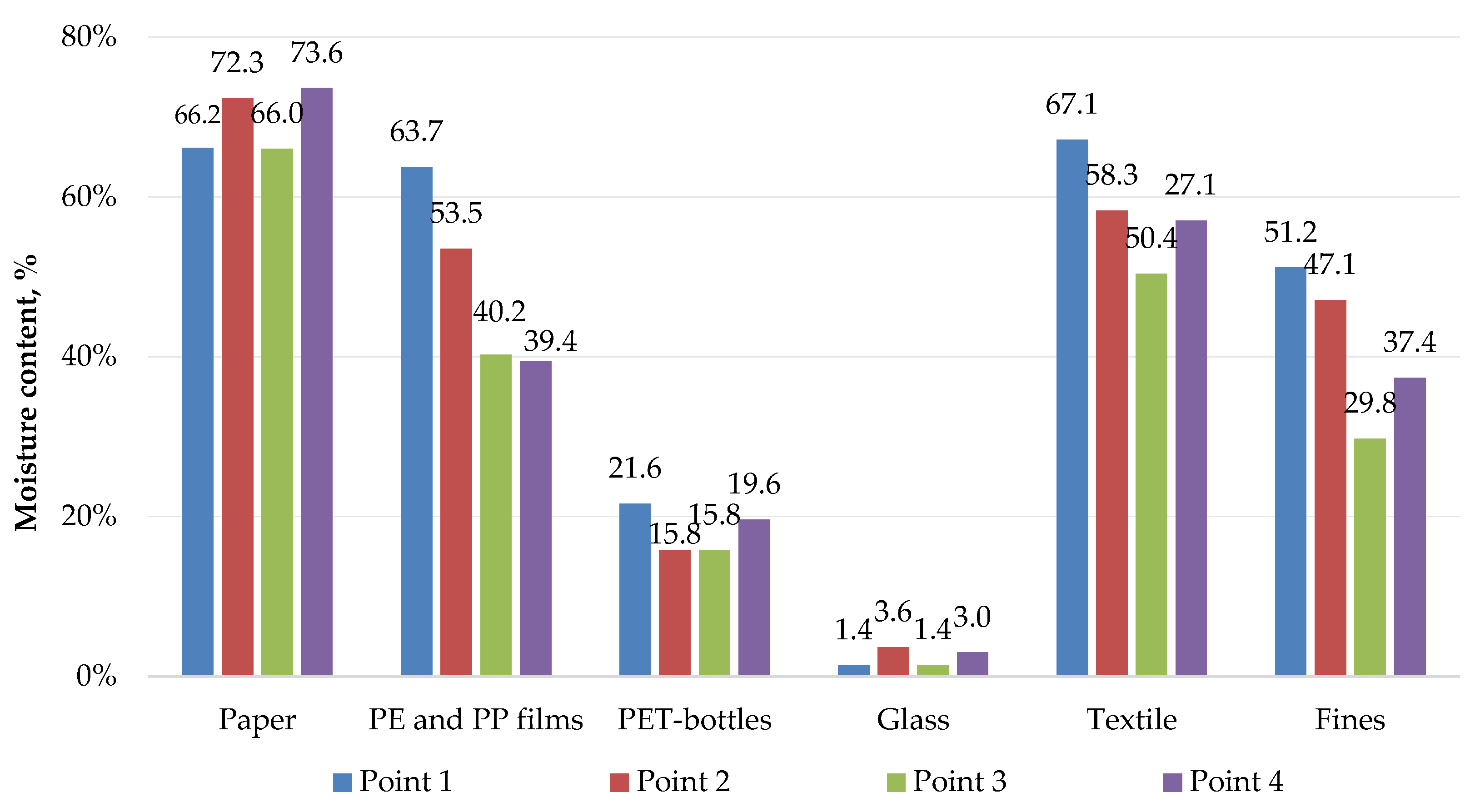
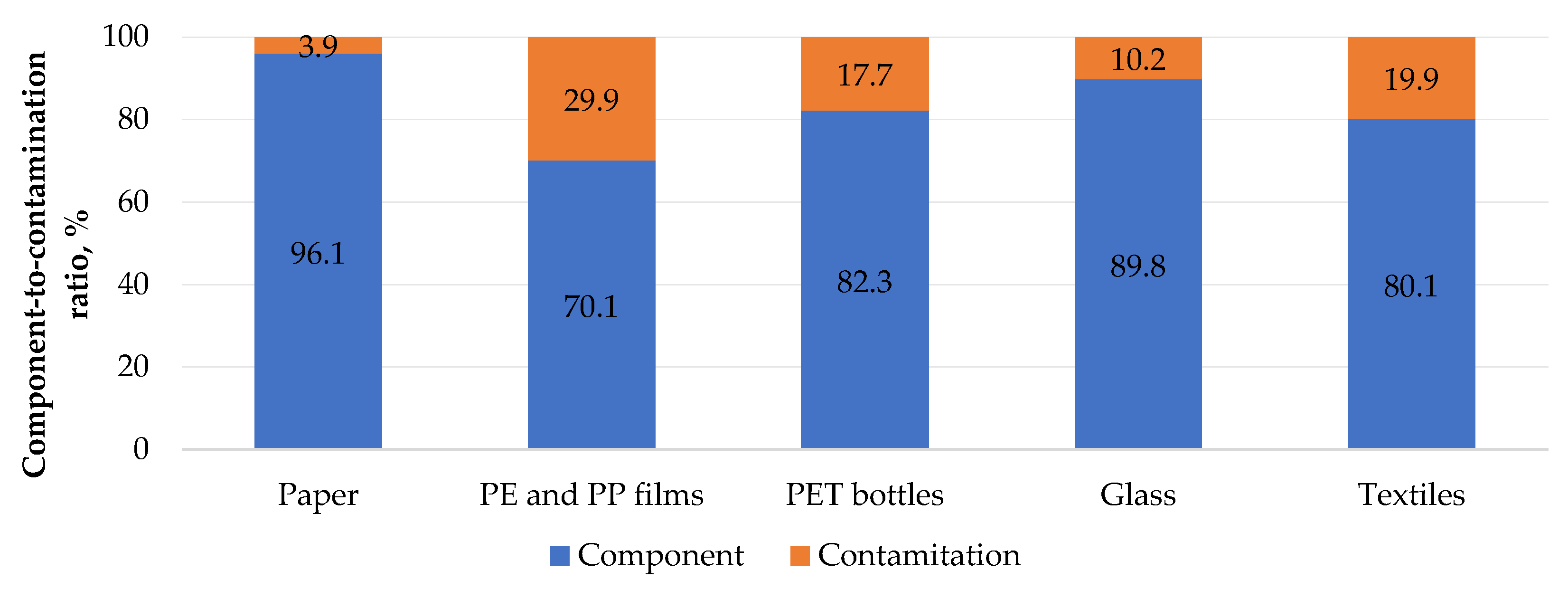
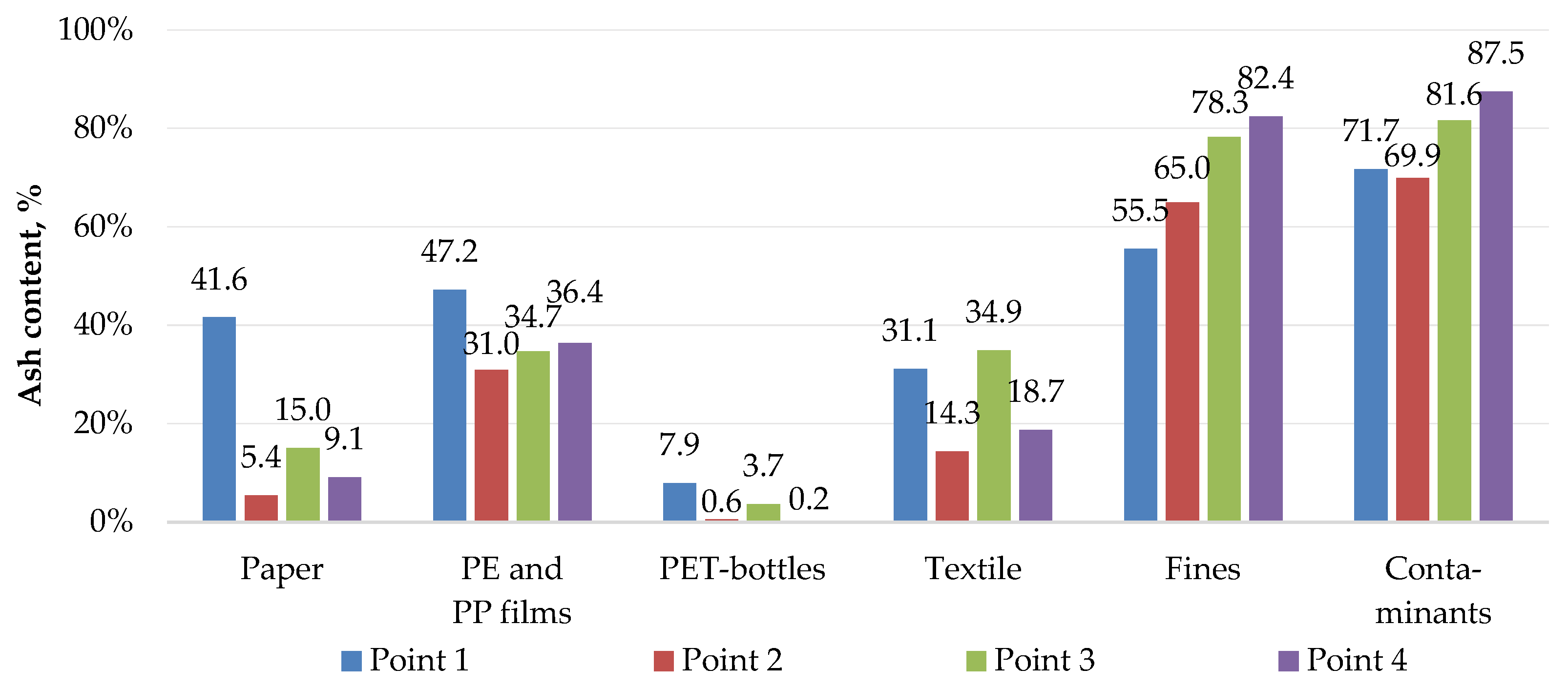


| Sampling Depth, m | Point 1 | Point 2 | Point 3 | Point 4 |
|---|---|---|---|---|
| 1.0–1.5 | Sample 1.1 | Sample 3.1 | Sample 4.1 | |
| 2.0–2.5 | Sample 2.1 | Sample 3.2 | ||
| 2.5–3.0 | Sample 1.2 | Sample 2.2 | Sample 4.2 | |
| 3.5–4.0 | Sample 3.3 | |||
| 4.0–4.5 | Sample 4.3 | |||
| 4.5–5.0 | Sample 2.3 | Sample 3.4 |
| Name of the Object (Country) | Landfill Lower Austria, Austria [8] | Landfill Styria, Austria [8] | Landfill Kudjape, Estonia [21] | Landfill Delhi, India [31] | Landfill Hyderabad, India [31] | Landfill Kadapa, India [31] | Landfill Debrecen, Hungary [22] | Landfill Inchuan, China [32] |
|---|---|---|---|---|---|---|---|---|
| Object characteristics | ||||||||
| Years of exploitation | 1982–2003 | 1979–2004 | 1970–2009 | since 1994 | since 1999 | since 1965 | since 1993 | 1989–2004 |
| Object area, ha | 7.8 | n/a | 3.9 | 16.16 | 123.22 | 4.04 | 20.1 | 11.3 |
| Sampling depth, m | 7–18 | 5–6 | 5 | 4–5 | 4–5 | 4–5 | up to 12 | up to 24 |
| Component composition, % | ||||||||
| Waste paper | 1.1 | 1.2 | 3.4 | n/a | n/a | n/a | 4.9 | 0.2 |
| Plastics | 10.3 | 8.2 | 17.4 | 3.3 | 2.7 | 3.7 | 20.6 | 10.6 |
| Textile | 4.4 | 2.7 | 17.4 | 0.8 | 1.4 | 1 | 4.6 | 1.5 |
| Wood | 5.4 | 1.6 | 3.4 | 0.2 | 1.5 | 1.3 | 5.3 | 2.4 |
| Leather | 5.4 | 1.6 | n/a | n/a | n/a | n/a | 5.3 | n/a |
| Rubber | 5.4 | 1.6 | 2.0 | n/a | n/a | n/a | 5.3 | n/a |
| Inert materials | 1.1 | 1.8 | 10.1 | 23.4 | 15.4 | 16.2 | 11.2 | 8.3 |
| Glass | 0.1 | 0.1 | 0.4 | 0.2 | 2.6 | 1.7 | n/a | 0.6 |
| Metals | 3.5 | 0.9 | 2.7 | n/a | n/a | n/a | 2.9 | 0.4 |
| Other | 6.1 | 4.0 | 6.6 | 0.2 | 3.3 | 0.9 | 0.5 | 1.0 |
| Fines less than 40 mm | 68.0 | 79.5 | 54.0 | 71.9 1 | 73.1 1 | 75.2 1 | 50.0 2 | 75.0 2 |
| Variables | Component Content | Ash Content on a Dry Basis | Moisture Content | Calorific Value on a Wer Basis | Calorific Value on a Wet Basis without Contamination |
|---|---|---|---|---|---|
| Component content | 1 | −0.231 | 0.847 | −0.183 | −0.229 |
| Ash content on a dry basis | −0.231 | 1 | 0.071 | −0.691 | −0.720 |
| Moisture content | 0.847 | 0.071 | 1 | −0.539 | −0.535 |
| Calorific value on a wet basis | −0.183 | −0.691 | −0.539 | 1 | 0.843 |
| Calorific value on a wet basis without contamination | −0.229 | −0.720 | −0.535 | 0.843 | 1 |
| Component content | 1 | −0.231 | 0.847 | −0.183 | −0.229 |
| Sampling Point | Net Calorific Value on a Wet Basis (MJ/kg) |
|---|---|
| Point 1 | 5.03 |
| Point 2 | 4.43 |
| Point 3 | 5.52 |
| Point 4 | 4.26 |
| Average | 4.87 |
Publisher’s Note: MDPI stays neutral with regard to jurisdictional claims in published maps and institutional affiliations. |
© 2022 by the authors. Licensee MDPI, Basel, Switzerland. This article is an open access article distributed under the terms and conditions of the Creative Commons Attribution (CC BY) license (https://creativecommons.org/licenses/by/4.0/).
Share and Cite
Shcherbinina, I.; Polygalov, S.; Ilinykh, G.; Korotaev, V.; Sliusar, N.; Mihajlovic, I.; Stanisavljevic, N. Energy Potential Assessment of Excavated Landfill Material: A Case Study of the Perm Region, Russia. Recycling 2022, 7, 7. https://doi.org/10.3390/recycling7010007
Shcherbinina I, Polygalov S, Ilinykh G, Korotaev V, Sliusar N, Mihajlovic I, Stanisavljevic N. Energy Potential Assessment of Excavated Landfill Material: A Case Study of the Perm Region, Russia. Recycling. 2022; 7(1):7. https://doi.org/10.3390/recycling7010007
Chicago/Turabian StyleShcherbinina, Iuliia, Stepan Polygalov, Galina Ilinykh, Vladimir Korotaev, Natalia Sliusar, Ivana Mihajlovic, and Nemanja Stanisavljevic. 2022. "Energy Potential Assessment of Excavated Landfill Material: A Case Study of the Perm Region, Russia" Recycling 7, no. 1: 7. https://doi.org/10.3390/recycling7010007
APA StyleShcherbinina, I., Polygalov, S., Ilinykh, G., Korotaev, V., Sliusar, N., Mihajlovic, I., & Stanisavljevic, N. (2022). Energy Potential Assessment of Excavated Landfill Material: A Case Study of the Perm Region, Russia. Recycling, 7(1), 7. https://doi.org/10.3390/recycling7010007








